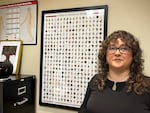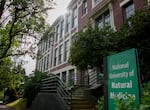Editor’s note: This story is the first in a two-part series about the challenges Portland alternative medicine graduates are facing in paying off their debts. The second of the series published Friday.
By the end of this week a leading institution among alternative medicine schools in the United States will be no more.

The exterior of Oregon College of Oriental Medicine, a private school offering graduate degrees in acupuncture and traditional Chinese medicine, Old Town Portland, Aug. 19, 2024. Trustees voted to close the school on May 15, 2024, citing financial issues and low enrollment.
Anna Lueck / OPB
The Oregon College of Oriental Medicine awarded its final master’s and doctorate degrees — it’s shutting down its public clinic and saying goodbye to its downtown Portland building.
Administrators at OCOM blame the downfall of the once prestigious acupuncture school on recent, outside forces: rising costs associated with the pandemic, the central city’s very visible homeless population and declining enrollment. But current and former students and faculty who spoke to OPB said the college’s collapse is rooted in problems at the institution going back many years.
Graduates disagreed with how their tuition dollars were being spent. They described enduring high staff turnover and what they considered to be predatory student loan practices.
The students fell into a system that OPB has found plagues several alternative medicine schools: students felt administrators encouraged them to take out hundreds of thousands of dollars in student loans while obscuring the reality that they’d end up earning less than a high school graduate.
Now students have been left with mountains of debt they say they’ll never be able to pay off.
Sold a fantasy
The students’ stories are similar.
They were drawn to holistic forms of medicine, like massage and acupuncture. Some have personal experiences of Eastern medicine working for them when Western medicine could not. They wanted to bring similar relief to people and dreamed of working alongside traditional doctors in healthcare clinics.
Continuing their education was the first step.
“We showed up at OCOM’s doorstep ready and willing — just really being inspired by the idea that we could help people through options other than surgeries and drugs,” said Lisa Pool, a 2007 OCOM graduate and licensed acupuncturist in Oregon.
Students thought schools like OCOM would propel them into lucrative careers in the alternative medicine field. They enrolled in yearslong programs, graduating with masters and doctorate level degrees in acupuncture and Chinese medicine. Many took out hefty student loans.
Over the decade that followed, the situation didn’t get any better.
A student who graduated from OCOM in 2015 and 2016 borrowed a median of about $175,000 in federal Stafford and Grad PLUS loans to complete their degrees, according to U.S. Department of Education data. Tuition and fees at the college cost upwards of $25,000 per year at the time, according to The Princeton Review.
It was a lot of money, but Pool and other OCOM graduates told OPB that admissions staff reassured them that the alternative medicine field was growing and that good jobs would be available. They remember the school highlighting successful alumni, some earning six-figure salaries.
“OCOM said, ‘Hey, when you get out of school, you’ll be able to make this amount of money,’” Pool said. “We thought the loan would be justifiable by the amount of income we would have.”

Lisa Pool is a licensed acupuncturist in McMinnville, Ore. She graduated from the Oregon College of Oriental Medicine in 2007 with over $100,000 in student loans.
Tiffany Camhi / OPB
But after graduation, the jobs weren’t there. The people who could find jobs mostly worked as independent contractors, without benefits.
The pay was dismal, with OCOM graduates typically making less than the average high school graduate. The median earnings for a 2015 and 2016 OCOM graduate four years after graduation was just above $27,000 a year, according to data from the U.S. Department of Education and the Internal Revenue Service. Jobs in alternative medicine aren’t generally high-paying, but the government figures show OCOM graduates earned about $7,000 less than the median earnings of graduates who attended other alternative medicine schools.
Wage estimates from the Oregon Employment Department show higher levels of pay — a median hourly wage for acupuncturists at $36.60. But state data does not include the majority of practitioners in the field, people who are self-employed or independent contractors.
A graduate success handout published by OCOM in 2021 focused on licensure pass rates as a measure of achievement. It showed the vast majority of its graduates, 88%, were self-employed. The document also reported an estimated median gross income of about $57,000 for its graduates, based on alumni surveys. Other alumni profiles highlighted graduates’ careers but did not include salary information.
With staff positions low-paying, and hard to find at all, graduates quickly learned they would have to start their own acupuncture business if they wanted to continue to practice. But many felt OCOM did not equip them with the skills to own their own businesses, like accounting or guidance to navigate insurance reimbursements. High student loan debt barred many graduates from taking out small business loans.
Pool graduated from OCOM with $108,000 in student loans in 2007. Her loans paid for tuition and living costs in Portland. Because of compounding interest, she now owes $230,000.
Red flags among alternative medicine schools
Portland is home to two of the nation’s most well-regarded private, nonprofit alternative medicine schools: OCOM and the National University of Natural Medicine, or NUNM. Many of the student loan issues that have beleaguered OCOM, and likely contributed to its closure, are echoed at NUNM, according to graduates of both schools and federal data.
With OCOM closing this week, students have the choice to complete their degrees at NUNM. But NUNM suffers from some of the same problems, including that students tend to accumulate vast amounts of debt only to earn low wages after graduation.
Among the thousands of graduate level degree programs offered at various universities and colleges throughout the U.S., OCOM has the third highest debt-to-earnings ratio for graduates enrolled in its alternative medicine degree programs at 651%. NUNM is ranked first on the same measure at 765%. That’s according to available data on more than 6,000 graduate-level degree programs tracked by the U.S. Department of Education in the most recent College Scorecard field-of-study report.
The report shows the debt-to-earnings ratio is under 296% for nearly all graduate-level degree programs in the U.S.
For some students, the warning signs at both schools were apparent immediately.
Bex Groebner is a licensed acupuncturist, 2011 NUNM graduate and former faculty member at both NUNM and OCOM. She said she was shocked by the $80,000 price tag for a four-year program. Groebner said admissions staff at NUNM encouraged her to take out loans, not only for tuition but also for living expenses, including child care.
“They said, just borrow [federal] loans and put them in preschool,” said Groebner. “And I was like, can I even do that? That sounds crazy.”
Child care expenses are an allowable cost-of-living expense for federal student loans. Groebner said NUNM staff reassured her that no graduates had defaulted on their loans. She ultimately borrowed $144,000 for her degree.
“What I heard, and what they meant for me to hear, was ‘You can pay this off,’” said Groebner. “But they knew, full well, that’s not what that meant.”
College Scorecard did not have loan default data available for NUNM alternative medicine graduates but it did show more than half of the school’s students had made no progress on paying down the principal of their student loans three years after graduation. There was no data available for OCOM graduates.
Groebner believes most NUNM and OCOM graduates are on federal income-driven repayment plans. These types of plans help make paying loans more affordable for borrowers by limiting payments to a small percentage of a borrower’s discretionary income. But because of interest, the plans trap low-income borrowers into loan balances that grow larger over time, even if they faithfully make payments every month.
“[Graduates] weren’t defaulting because they were barely making any money,” said Groebner, who knows the repayment plan trap herself. Her loans have grown to more than $400,000 due to compound interest.
NUNM President Melanie Henriksen said the school is committed to transparency with students regarding program costs and career opportunities.
“NUNM offers financial counseling to help students understand the implications of taking on student loans, including the debt-to-income ratio,” said Henriksen in an emailed statement to OPB. “We encourage students to seek additional financial advice to ensure they are fully informed about their financial commitments and strategies for managing debt.”

The exterior of a building housing National University of Natural Medicine, the oldest accredited university of naturopathic medicine in North America, on the university's campus near downtown Portland, Aug. 19, 2024.
Anna Lueck / OPB
People who have graduated from OCOM more recently said their degrees took longer to complete and were, therefore, more expensive than they needed to be. Other acupuncture schools offer similar degrees in three years instead of four. They said some classes were repetitive, reteaching basic elements of Chinese medicine theory in multiple classes. Graduate programs could have been made less costly, if administrators streamlined curriculum, said Groebner.
“Faculty were asking for the fat to be cut off the program for a long time,” said Groebner, who’s worked at OCOM since 2015 as a teaching assistant and as a faculty member since 2023. “There were so many unnecessary classes and credits.”
Conversely, graduates said key courses that taught skills they would actually need in their career, like hands-on experience with needles, were not introduced until two years into the acupuncture program. An OCOM administrator said some of that was necessary, with students needing to complete prerequisites before working with needles.
Both OCOM and NUNM require incoming students to have at least a three-year bachelor’s degree and to have completed courses in biology, chemistry and psychology.
One OCOM student who graduated this week said financial sustainability was not brought up to students in the class of 2024 until last month. The student said a guest professor walked through how to sustain a small business while managing high student loan debt.
“Why didn’t we have this class four years ago?” the student asked. “I was just laughing to myself, whose idea was it to put this class at five weeks until graduation?”
OPB is not identifying the student, because they’re concerned that revealing even their first name could hurt their job prospects in the small community of alternative medicine practitioners.
The student said OCOM marketed itself as a medical school — so they looked into transferring to another school to become a nurse or physician’s assistant. But none of their credits would have transferred. A spokesperson from Oregon Health & Science University said, in theory, OHSU could accept appropriate transfer credits for a bachelor’s or graduate degree but it would not be expected as the curriculum at alternative medicine schools is highly specialized.
“To find out that years of school credits are basically meaningless anywhere else was really a blow to me,” the student said. “I felt like they lied to me.”
OCOM’s CEO Phil Lundberg said the school markets itself as an acupuncture and Chinese medicine school.
The student also echoed the concerns of other OCOM graduates — that staff and faculty turnover was frequent, including in key academic leadership and financial aid positions. Lundberg took over as the school’s president in 2023.
This student is graduating from OCOM with a similar burden as Groebner and Pool more than a decade ago. Their student loan debt, which covered tuition and living expenses in present-day Portland, totals about $300,000.
Issues compound at OCOM
The reasons for OCOM’s closure are complex and many of the school’s financial issues were outside of its control, said Lundberg. The biggest factor in recent years, he said, was the COVID-19 pandemic.
“The simple answer is we weren’t consistently able, since the pandemic, to recruit enough students to break even,” said Lundberg.
OCOM also joins several other acupuncture schools that have shut down in the past year, including the Academy of Oriental Medicine at Austin in Texas and the American College of Traditional Chinese Medicine in San Francisco.
Before 2020, OCOM enrolled an average of around 300 students, welcoming around 50 new students each year. The school’s enrollment figure halved after the pandemic falling to 160 in 2022. That spelled disaster for the school, which relies heavily on student tuition dollars to stay afloat.
According to recent tax forms, over 80% of OCOM’s revenues were coming from student tuition. About 65% of NUNM’s revenues are from tuition.
That’s high, compared to other institutions. A National Center for Education Statistics survey of revenue sources showed tuition accounted for about 40% of revenues for 4-year private, non-profit medical and health profession schools in 2020-21.
A 2019 white paper studying the closure of higher education institutions in the United States found that schools depending on tuition as their main source of revenue are more likely to fail. The research paper also noted that private, specialized schools, like OCOM, are more at risk of closure.

An acupuncturist who graduated from the Oregon College of Oriental Medicine places needles in a patient, Aug. 19, 2024. Many OCOM graduates said the school misled them about the job opportunities available in the alternative medicine workforce.
Anna Lueck / OPB
And as enrollment declined, tuition increased for students. Lundberg said the school did what it could to keep costs down for its students but updated course criteria from OCOM’s accreditor and state medical boards meant the school had to add material to its programs instead of streamline.
According to federal data from the National Center for Education Statistics, OCOM spent more per-student than peer institutions in every core expense category, including academic support, instructional support and student services. In the most expensive category — instruction — the college spent $1,100 more per-student than the peer average.
Lundberg said adding more business-focused classes would have increased costs for students even more.
OCOM always had students’ best interest at heart, Lundberg said.
“We always wanted to make sure that the students were academically prepared, had the ability to be successful in our program and then to go on to successful professional careers,” Lundberg said.
Pool disagrees and said OCOM’s own administration contributed to its downfall. She pointed to the decision to move the school from its original Southeast Portland location to Portland’s Old Town neighborhood in 2012. The college underwent a costly $15 million building renovation. OCOM’s CEO at the time said the move would improve the school’s visibility and be able to accommodate more students. Pool said students, faculty and graduates of the college were opposed to this move.
“We all knew it would be a bad financial decision,” said Pool. “They did it anyway.”
Lundberg said OCOM’s downtown building was appraised at about $13 million before the pandemic. A more recent appraisal estimated the building could sell for $3 million, about half of what the college originally paid for it.
Pool said instead of investing in a new building, the school should have focused more on helping students start their careers after graduation.
“Not participating in making sure students would be successful — not only while they were attending, but also when they left — that snowballed into them closing,” said Pool, who has discouraged people from attending OCOM.
For Pool and many other people like her, the picture of success the alternative medicine schools painted seemed like a golden opportunity. An opportunity that, if true, was worth the school’s price tag.
But that hasn’t been the case for the average graduate. And now Pool is helping lead an appeal to the U.S. Department of Education to get hundreds of OCOM graduates’ federal student loans discharged. However, Pool and other former OCOM students are finding that getting financial relief or accountability for their high-debt, low-income situations is not easy.
